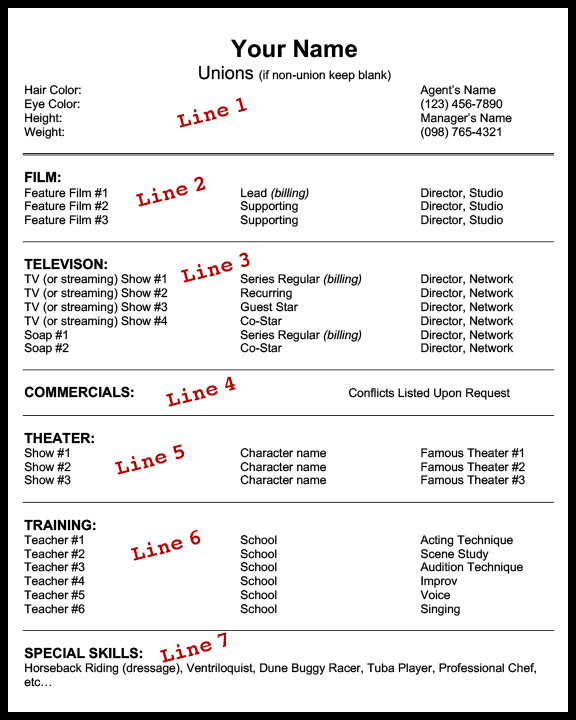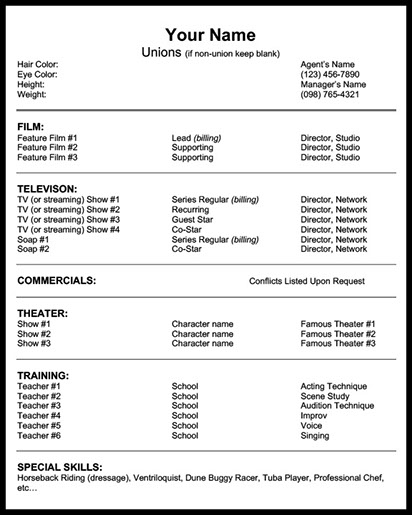Resumes
Here is a ton of helpful information regarding the where, what, when and why’s of a professional actor’s standard resume.
Copyright Notice
All materials on these pages are copyrighted and made available for your use only. Do not distribute these to anyone in the public without prior permission from Mark Atteberry or Be A Working Actor Studios.
The Industry
Standard Resume
Your resume is your calling card. It shows what you’ve done and a little about you.
CREATING THE ACCEPTED ACTING RESUME
Although most of casting takes place online these days, occasionally you may find the need for a standard printed actor’s resume. We’ve outlined here exactly what that is. Creative interpretations of billing are common on actors’ resumes. Certainly, there can be small variations from market to market, but the basic standard for a Los Angeles actor’s resume, and for most other acting markets as well, is clear. Although, some markets may change the order of categories. That said, use this as a guide, especially if you are here in LA. Refer to the example to the right (or below on your phone or tablet) as you read through the thorough instructions below. The information herein is also valuable for online resumes.

OVERALL GUIDELINES
List your roles in order of your last booking first. That said, it is generally okay (and often recommended) to list your largest two or three roles at the top (or at least near the top) of each category. But, try to keep them as close to in order as possible.
With all issues of billing, check your contract. If you are working a union television contract, your billing will be spelled out specifically in your contract and there is no room for error. If you do not have a contract or deal memo for your work, check the original breakdown for the project, as the billing for the role will likely be listed after the character description. When in doubt, check with your agent or someone in production. You do not want to mistakenly upgrade yourself on your resume and then meet up with the casting director in the future. Bottom line, don’t lie! You might get caught.
Keep your resume readable and simple. If you have numerous credits (and don’t we all wish we had that problem) you don’t have to list all of your credits. It is fine to list your strongest credits and then write “partial list” somewhere around that category. Again, keep it simple!
*An acting resume is for speaking roles only. Background work is not to be listed on a standard Hollywood acting resume, even if you were a “featured extra.” If you were booked for a speaking role and you shot the project but were cut out or your lines were cut you can still list it on your resume, especially if you are in the credits.
Line 1 – The Header (top)
Put your name at the top in the center. Below that put your union affiliation. On one side below that put your hair color, eyes color, height, weight and website (optional). On the opposite side list your contact number or agency information. Some actors fit a small headshot on the top but that is completely optional and most don’t do that. Again, there is some leeway to get creative but keep it simple and readable above all else.
Line 2 – Feature Film Billing
The title of the film goes on the left, the billing in the middle and the director and studio on the right. The following are how roles are billed and listed in the film category.
Lead: Principal role in the film, in most scenes, on-screen credit is often in the credits that open the film (as well as in the complete end credits).
Supporting: Principal role in the film, in one or more scenes but not a lead character although important to the storyline.
Line 3 – Television Billing
The title of the television (or streaming) show goes on the left, the billing in the middle and the director and studio/network on the right. The following are how roles are billed and listed in the television category.
Series Regular: Contract role with exclusivity to the series, network, and production company for a term of a year or more; paid for a predetermined number of episodes produced, on contract for all episodes, even those in which the character doesn’t appear.
Recurring: The character returns over multiple episodes, either on standing contract or contracted periodically, based on negotiations and number of appearances. You can be billed as either a Recurring Guest Star or a Recurring Co-Star.
Guest Star: One-episode actor whose character’s storyline is central to that episode, works at a weekly rate (and can be under contract for the week, even if only shooting a day or two).
Co-Star: One-episode actor whose character’s storyline may or may not be central to that episode. Since co-star billing actually depends more on negotiation than size of the role, it can be anywhere from one line to multiple scenes.
Line 4 – Commercial Billing
It is standard on most Hollywood resumes to write “Conflicts Listed Upon Request” in this category.
Line 5 – Theatre Billing
The title of a theater credit goes on the left, the character name in the middle and the theater on the right. The following are how roles are billed and listed in the television category.
Billing is usually not extensive for theatre credits on a resume since Hollywood is mostly a Film and TV town. That said, many casting directors are impressed with Broadway, Off-Broadway or known theater credits so it is standard to include this category on a resume. Definitely list theater credits if you have only a few film and/or TV credits. If, however, the production is of an original work or a relatively new play, it is fine to include a parenthetical notation of “lead” or “supporting” after the character name.
Line 6 – Training
List the teachers you have studied under, in the order you studied with them. You should also list what they teach. Some examples of types of training are “Acting Technique,” “Scene Study,” On- Camera Technique,” “Comedy,” Improv,” “Voice,” “Dialects,” “Dance,” etc.
Line 7 – Special Skills
This is not a place to list everything you think you can do (just hoping to grab the casting director’s attention). This is a place for you to list the special skills that you have mastered and that set you apart from most other actors. In this category you can list skills you have in the various arts, sports and life. Focus on what’s unique about what you can do.
*If you need help with any of this, we can help. Contact us here
Resume Templates
Use these standard acting resume templates to design your own resume.

